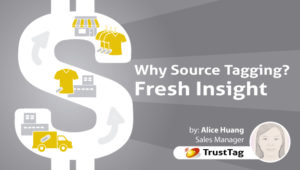
By Simon Shi
Having a secure retail store is at the forefront of every merchant’s mind. And with theft being a constant threat to retail security, more stores are looking to source tagging as both an effective and painless way to bolster loss-prevention methods.
Not every retailer using these methods are implementing source tagging effectively; some are pointed in the entirely wrong direction. Let’s take a look at an overview of source tagging and how to make the best use of it for your retail store.
What is Source Tagging?
Source tagging (a type of Electronic Article Surveillance, or EAS), is when a small electronic device is embedded into packaging or is sewn unobtrusively onto the product itself. The tiny detectors are placed on products at or near the source (the supplier or manufacturer) rather than at the retailer.
The retailer’s vendors are authorized to obtain the tags and tag the items themselves before shipment, cutting down expensive labor costs for employee time spent tagging items in the store. Source tags come in a variety of shapes and sizes, but are always easy to handle and are incredibly effective for loss-prevention.
Why Retail Theft is a Problem
More companies are choosing to use source tagging because of the overwhelming statistics of shoplifting. In taking the United States into account, there are over 550,000 incidents of shoplifting per day, and a startling 13 billion dollars’ worth of goods stolen every single year – equating to 35 million dollars every day! Even 75 percent of employees have been found to engage in shoplifting.
Retail thieves are only caught 1 in 48 times, and they often wear large coats or use baby strollers, umbrellas, or large shopping bags to drop items into. Source tagging aids in mitigating the substantial losses incurred by retail losses.
Source Tagging Benefits
Source tagging is a reliable method for theft detection for products of any size or value. A Visible Source Tag (VST) extends high security and deterrence factors, and a sewn-in label can offer discreet EAS protection. Either option is easily deactivated or removed at the retail POS and chips away at valuable employee time often bogged down by tagging items. Additionally, source tagging decreases shrinkage, helps to increase in-stock rates, and can be a driving force in increasing sales. But above all, source tagging is one of the most effective ways to increase loss prevention.
How To Implement Source Tagging
The source tagging supplier you choose should be a professional entity and should be located close to a retailer’s manufacturing vendors. Many retailers in the United States choose their packing companies to aid with source tagging, which doesn’t end up working to the retailer’s advantage as manufacturers don’t provide the quality and professionalism that professional source tagging companies can offer. Source tagging companies communicate directly with vendors to ensure a retailer’s security needs are met. Make sure to choose trusted source tagging companies with dependable reputations – your products are your business, and your business is your livelihood!
TrustTag is a Chinese source tagging company that provides a myriad of source tagging and other precision-engineered security services for any manufacturers located in Asia. Contact us for any questions about how we can help your retail store mitigate loss prevention.
